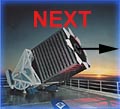| Galaxies | ||
 | ||
| Classifying | ||
| Hubble Tuning Fork | ||
| Characteristics | ||
| Clusters | ||
| Separating | ||
| Spectra | ||
| Collisions | ||
| Conclusion | ||
| Your Results | ||
Galaxy CollisionsDid you notice how many galaxies are in a cluster like Abell 2255? When that many galaxies share relatively small area of space, it should not be surprising that galaxies sometimes collide. In fact, the Milky Way Galaxy is colliding with the Sagittarius Dwarf Galaxy right now. Although galaxy collisions are common, stars are so far apart that collisions between stars are very rare.
Even if galaxies don't directly collide, though, they can still affect one another. When two galaxies pass close to one another, the gravitational force they exert on one another can cause both galaxies to warp. Both crashes and near misses between galaxies are referred to as "interactions." At the right you can see two galaxies interacting. You can see they are being distorted by the gravitational interaction between them. Can you imagine what they might have looked like before the interaction? Interactions frequently lead to a burst of star formation. Inside each galaxy, clouds of gas that were relatively sparse may become compressed. Compressing the clouds can cause them to undergo gravitational collapse, leading to a new generation of stars in a galaxy where normal star formation may have ceased long ago.
You can study this process by watching it happen on your computer! Astronomer Chris Mihos and his colleagues from Case Western Reserve University and the University of Oregon have written a free Java applet that simulates interacting galaxies. Go to their web site by clicking here. Click Applet to launch the applet. A new window will open, and the program will take a moment to load. Click Controls to launch a small window describing the applet's controls. Change the angles of the galaxies with respect to each other by clicking the dials with the left or right mouse buttons. Change their separation distance by changing the "Peri" variable, and change the mass of the red galaxy with respect to the green galaxy by changing "Red Galaxy Mass." If you don't see both galaxies in the window to the right, click Reset. To start the simulation, click Start. You will see the two galaxies interact in the right side of the window. The window also shows the elapsed time in millions of years and the separation of the galaxies in kiloparsecs (1 kiloparsec = 1000 parsecs = about 3000 light-years). The graph at the bottom shows the separation (red) and the relative velocity of the galaxies (blue) as a function of time. If you're interested in learning more about what galaxies look like when they interact, use the applet to answer the questions below. Otherwise, click Next.
|
|||

 |